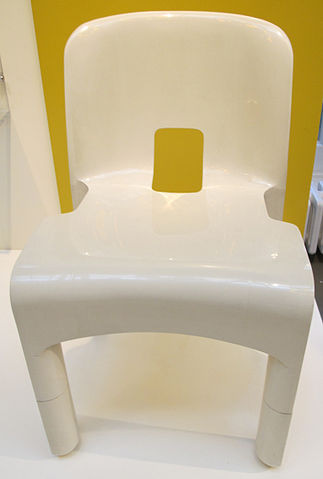Universale Chair by Joe Colombo
Joe Colombo
The Italian industrial designer Joe Cesare Colombo (unrelated to the famous maphia boss) lived a relatively short life. He died unexpectedly on his 41st birthday in 1971, but his legacy was a powerful one. Originally trained as a painter at Accademia di Belle Arti di Brera, he became interested in design and saw himself as a ‘creator of the environment for the future.’ While some of Colombo’s creations indeed remain futuristic, the Universale chair can make us feel as if future has already arived. And perhaps has already passed.
Universale
Not unlike many other furniture designers, Joe Colombo welcomed the challenge of modern industrial trends. In the early 1960s, he decided to design a chair that could be mass-produced from a single form. The recent events in space exploration and the explosion of science fiction in the 1950s also contributed to the ideation process. After initial experiments with aluminium, the designer settled on using ABS plastic (Acrylonitrile butadiene styrene). This material remains very common today and is used, among others, for making Lego sets (although ABS is going to be soon eliminated by the company). Everyone who is familiar with Legos can testify that the material is durable and resilient, but most importanly very colorful. Although the material was ultimately switched to polypropylene, t, the change over to plastic was a huge bonus for Colombo. Brilliant colors gave his newly designed chair a look reminiscent of the Pop art, prevalent at the time. The Universale was a part of the trend that demonstrated how plastics could be more than just cheap and practical.
By the way, the hole in the back of the chair is supposedly purely practical. It was needed in order to remove the chair from the mould (you can also use it to carry the chair). Of course, we can be confident that a true designer like Joe Colombo spent a good amount of time shaping this necessary orifice.
Eventually, the functionality of the chair became more important than the single-form production in an injection mould process. Colombo was interested in having the same chair transformable and reusable for different purposes. He designed a system of interchangeable screw-on legs, capable of transforming a dining-room chair into a bar stool (and back). In theory, this also created possibilities for color variations and unique looks.

Where to buy an Universale chair
By today standards, the Universale chair may look a bit bulky, but its forms remain noble and reassuring. Of course, they are still practical and can be easily stacked, althought it is unlikely that anyone will be stacking chairs that are essentially museum pieces (many original production Universale chairs indeed are). The chairs are still produced by Kartell, Italy and sold in sets or as sigle pieces for as little as $500. You will not find cheap imitations, as the design has not been licensed out. The maker’s mark typically reads something like Kartell Binasco (Milano), Made in Italy, Designed by Prof. Joe Colombo.
How to use Universale chairs
These creations would look best in open concept spaces, as long as the colors they bring in work together with the environment to achieve design goals. If you are getting a set, consider boldly mixing up the colors within the same palette. As it often happens, these chairs are excellent conversation starters: about future, plastics, Lego and what can be achived in a short life. Because every life is short.
More information on the Universale chair
100 Midcentury Chairs: and their stories by Lucy Ryder Richardson
Resistant Materials by Lesley Cresswell, Barry Lambert